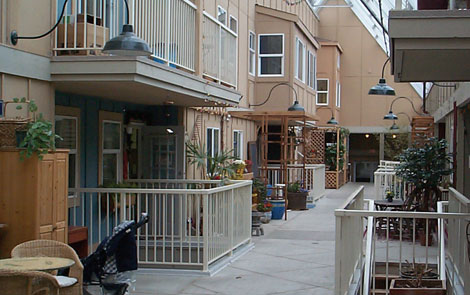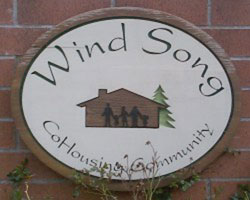|

Inside WindSong Cohousing
By Hugh Perry
The first architecturally designed cohousing project in Canada has preserved the community feeling that characterizes cohousing.
Moving along the city street of Langley, British Columbia, one crosses a small creek shouldered by narrow environmentally protected wetland banked by housing development on both sides. Immediately across the bridge begins a wooded lot with mature cedars lining the sidewalk. Then a little sign that reads, “WindSong CoHousing Community” peers from amidst the cedars, sparking intrigue.
The first glimpse of the building says that this is a place of organized ingenuity in action. The visitor parking lot skirts around tall trees left during construction in 1996. Ground covering plants fill the remaining spaces between traffic walkways and buildings. The glass atrium rises above the roofs of the dwellings, contributing to its unique look. At last, after many years worth of visiting communities and writing about communities, I had arrived at my model community.
In a secure front foyer we spoke to our host over the intercom, just as one would in any multi-family dwelling facility. Once inside, my attention was immediately drawn to the exposed, low maintenance, hand decorated concrete floors. The automatic watering system for hanging plants looked ingenious. Then our host Susan McFee eventually drew my attention to the many more architectural features.
We were standing in “the Heart,” Susan explained. That is the area where all the community’s functional spaces are located. These were purposely built near the entrance so that the traffic in and out of the building would flow through this space. This functionality serves to support community involvement, which is one of the main reasons for living in a cohousing community.
Every room off the two-story open area has windows facing the centre core. The commercially equipped kitchen/dining room portion is fully glazed and boasts a garage door that leads directly into the Heart. This door is fully extendable and serves as an open invitation for passersby to participate in special events. Group meals are served twice a week and members voluntarily take turns at kitchen duties.
Experience has given WindSong residents a workable formula for using the same kitchen in the preparation of conventional and vegan foods. They accomplish this simply through good scheduling, dedicated cutting boards and specific utensil usage. Although this can be a hot topic in any community living arrangement, this matter has been resolved to the satisfaction of all through consensus. The dining area also serves as a multifunction space with the addition of a small stage for talent shows, a large screen TV and an attached lounge with a fireplace. All this is complemented with a beautiful view of the outside, displaying Nature at its best.
WindSong is ethnically diverse and multigenerational. The 5,000-square-foot Heart includes three children’s play areas that are adapted to different ages. While I visited, a child played in the infant room under the care of a resident of grandparent age. Among the 90 or so residents of WindSong Cohousing, when I visited, there were five newborns. The upstairs loft is for the school age children and across the hall is the teen room, decorated by the teens themselves. As well, they have an art and craft studio/workshop.
Even though each unit has laundry facilities, each year more residents abandon their own in favor of the communal laundry room, perhaps due to the social opportunities available there. In a separate area, there is a well-equipped woodworking shop that comes complete with safety training.
Upstairs, a large all purpose room is at the disposal of those wishing to give or take lessons such as dance, yoga, etc. A well-equipped office space is also available for the use of anyone wishing to conduct business meetings, including the eight home-based businesses operating at WindSong. All the business equipment is shared and the users billed automatically for its use.
The work for the upkeep of this facility is shared by residents who either contribute four hours per month or pay $15 per hour for someone else to perform these tasks. Specific duties are chosen by each individual according to their personal preferences and include cleaning, gardening, repairs and public relations.
Overlooking the Heart are 34 units consisting of one to four bedrooms each. The units are owned as a strata corporation similar to condo ownership. Payment of maintenance fees are based on the size of the units and costs range from $225 to $450 per month, which includes taxes, insurance, maintenance of the property and utility cost of all the common areas. The individual units are smaller than conventional homes due to the sharing of facilities. As well, there is a guest suite that is shared by visitors, thus saving on rarely used extra bedroom space.
The architect allowed the contours of the land to dictate floor elevations. As a result, one wing follows the slope uphill while the other steps downhill in two stages. At the end of the lower level are stairs leading to the community gardens. This creates a lounge area on the floor above, overlooking the creek and gardens.
There are single story units on one side and two story on the other with optional balconies or windows looking into the glazed courtyard, giving it an early European look. Each resident has the option of stepping out into the courtyard for community exchanges or using their private door to the exterior if they wish privacy. The glass roof over the courtyard has functioning windows for natural cooling. The space is passively heated and is fully fire protected with sprinklers in all public areas.
Walking along the closed-in street, one meanders through a display of individual tastes in decor, for each resident personalizes the place in front of their home. This led me to inquire about how they managed order and possible conflict. Experience has taught that individual responsibility and tolerance coupled with the least amount of rules creates the best balance. Any personal conflict issue is dealt one-on-one between the involved parties. If and when necessary, a friend might be invited to intervene or as a last resort the concern might be discussed in a community meeting. At that stage, the outcome depends on consensus working its magic. Everyone, including the children, participates in meetings and each has an equal say through the consensual process.
The development works well from an environmental point of view. The footprint was kept to less than 50 percent of the property by developing just 2.2 acres of the six-acre property. They direct 100 percent of their storm water away from municipal infrastructure, have a good recycling program, provide secure bicycle storage, have minimized heat island effect with underground parking and have minimized site disturbance by designing to suit the property and also keeping the existing trees. Healthy, durable, long lasting, low maintenance materials were used in construction. Future upgrades being investigated include storm water reuse, radiant floor heating and energy recovery units.
Homeowners can sell their units at any time and to whomever. The screening process for new buyers favors the purchaser. Interested buyers are encouraged to share in activities and meetings and become familiar with the sharing rules to help in their decision to purchase.
Leaving the WindSong Cohousing property saddened me a little, but also strengthened my desire to some day build a similar cohousing project in my own area.
Learn More
WindSong Cohousing Community www.windsong.bc.ca
Reinventing Community: Stories from the Walkways of Cohousing by David Wann (Fulcrum Publishing, 2005)
Sustainable Community: Learning from the Cohousing Model by Graham Meltzer (Trafford, 2005)
The Cohousing Handbook: Building A Place For Community by Chris ScottHanson and Kelly ScottHanson (New Society Publishers, 2004)
Cohousing: A Contemporary Approach to Housing Ourselves by Kathryn McCamant and Charles R. Durrett (Ten Speed Press, 1993)
|

